NURS1003: Somalia's Challenges in Achieving SDG 4 Target 1
VerifiedAdded on 2023/06/13
|7
|2139
|319
Essay
AI Summary
This essay critically analyzes Somalia's progress towards achieving Sustainable Development Goal 4, Target 1, which aims to ensure that all girls and boys complete free, equitable, and quality primary and secondary education by 2030. The analysis uses a sociological imagination framework, considering historical, cultural, and structural factors that impede Somalia's educational development. The essay identifies challenges such as ongoing conflict, poverty, lack of government support, outdated curriculum, cultural norms that disadvantage girls, and the needs of nomadic communities. It also offers recommendations to improve the education system, including curriculum reform, increased government investment, addressing cultural barriers through capacity building, and providing learning resources to support student retention. Ultimately, the essay assesses the likelihood of Somalia achieving the SDG 4 target by 2030, given its complex and persistent challenges.
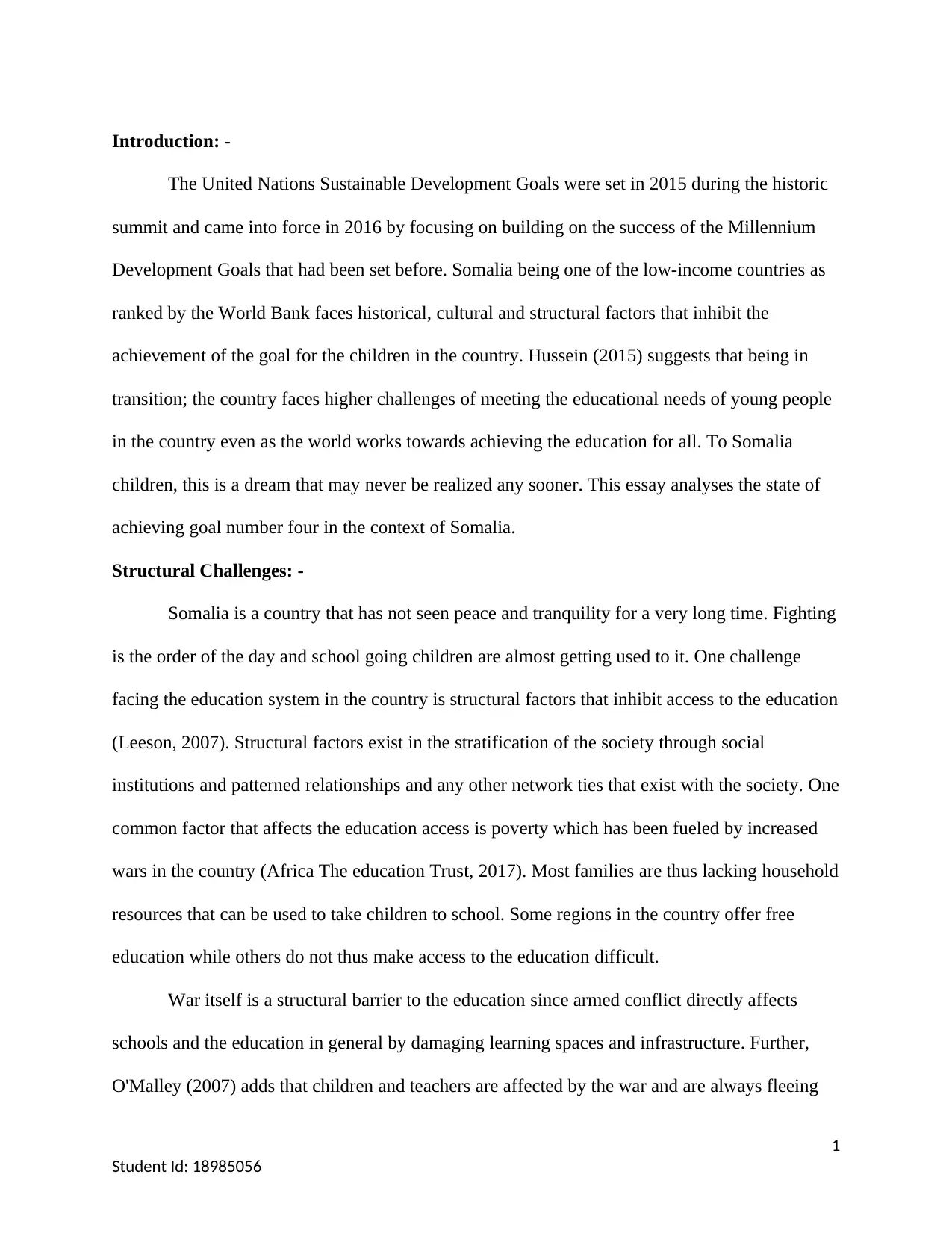
Introduction: -
The United Nations Sustainable Development Goals were set in 2015 during the historic
summit and came into force in 2016 by focusing on building on the success of the Millennium
Development Goals that had been set before. Somalia being one of the low-income countries as
ranked by the World Bank faces historical, cultural and structural factors that inhibit the
achievement of the goal for the children in the country. Hussein (2015) suggests that being in
transition; the country faces higher challenges of meeting the educational needs of young people
in the country even as the world works towards achieving the education for all. To Somalia
children, this is a dream that may never be realized any sooner. This essay analyses the state of
achieving goal number four in the context of Somalia.
Structural Challenges: -
Somalia is a country that has not seen peace and tranquility for a very long time. Fighting
is the order of the day and school going children are almost getting used to it. One challenge
facing the education system in the country is structural factors that inhibit access to the education
(Leeson, 2007). Structural factors exist in the stratification of the society through social
institutions and patterned relationships and any other network ties that exist with the society. One
common factor that affects the education access is poverty which has been fueled by increased
wars in the country (Africa The education Trust, 2017). Most families are thus lacking household
resources that can be used to take children to school. Some regions in the country offer free
education while others do not thus make access to the education difficult.
War itself is a structural barrier to the education since armed conflict directly affects
schools and the education in general by damaging learning spaces and infrastructure. Further,
O'Malley (2007) adds that children and teachers are affected by the war and are always fleeing
1
Student Id: 18985056
The United Nations Sustainable Development Goals were set in 2015 during the historic
summit and came into force in 2016 by focusing on building on the success of the Millennium
Development Goals that had been set before. Somalia being one of the low-income countries as
ranked by the World Bank faces historical, cultural and structural factors that inhibit the
achievement of the goal for the children in the country. Hussein (2015) suggests that being in
transition; the country faces higher challenges of meeting the educational needs of young people
in the country even as the world works towards achieving the education for all. To Somalia
children, this is a dream that may never be realized any sooner. This essay analyses the state of
achieving goal number four in the context of Somalia.
Structural Challenges: -
Somalia is a country that has not seen peace and tranquility for a very long time. Fighting
is the order of the day and school going children are almost getting used to it. One challenge
facing the education system in the country is structural factors that inhibit access to the education
(Leeson, 2007). Structural factors exist in the stratification of the society through social
institutions and patterned relationships and any other network ties that exist with the society. One
common factor that affects the education access is poverty which has been fueled by increased
wars in the country (Africa The education Trust, 2017). Most families are thus lacking household
resources that can be used to take children to school. Some regions in the country offer free
education while others do not thus make access to the education difficult.
War itself is a structural barrier to the education since armed conflict directly affects
schools and the education in general by damaging learning spaces and infrastructure. Further,
O'Malley (2007) adds that children and teachers are affected by the war and are always fleeing
1
Student Id: 18985056
Paraphrase This Document
Need a fresh take? Get an instant paraphrase of this document with our AI Paraphraser
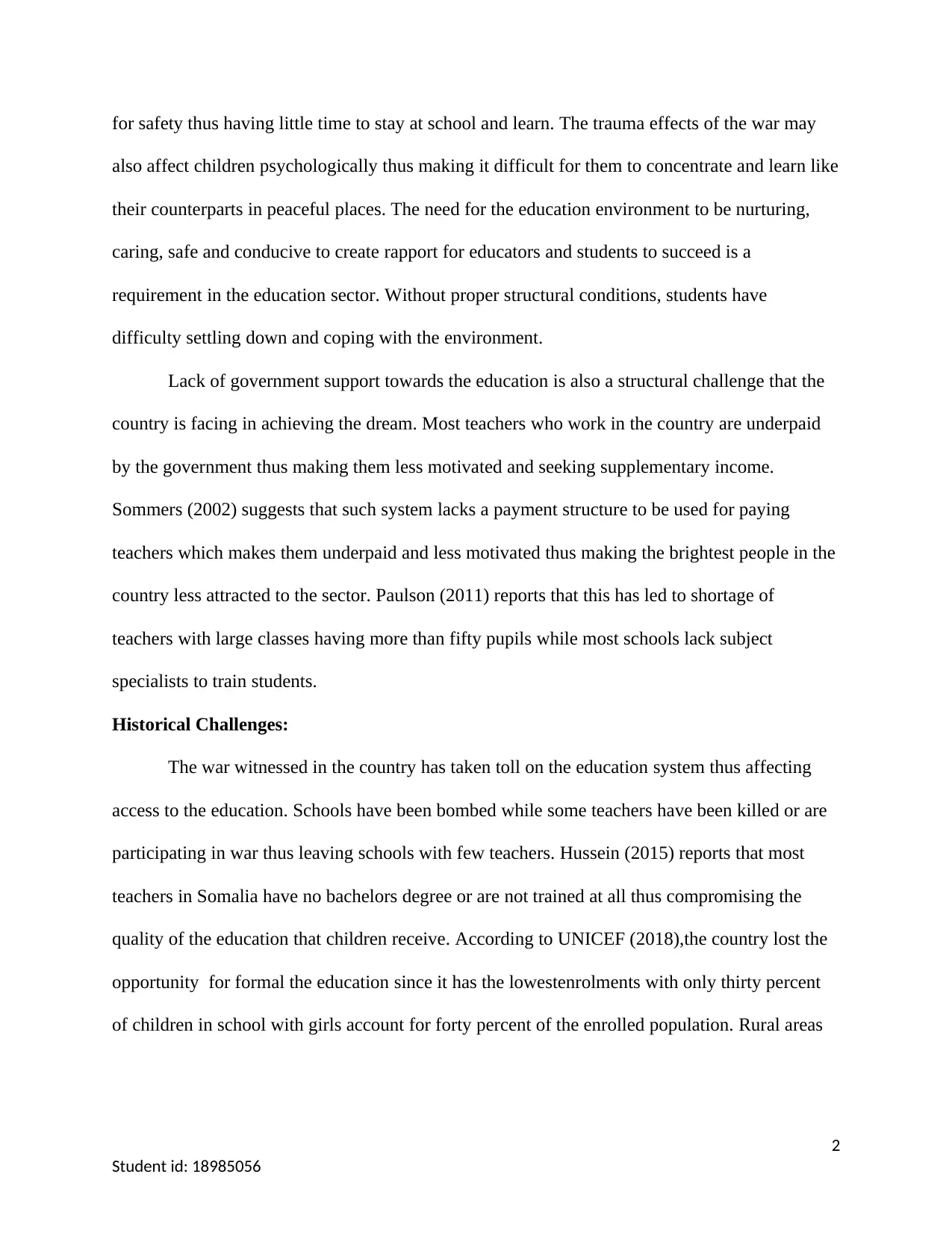
for safety thus having little time to stay at school and learn. The trauma effects of the war may
also affect children psychologically thus making it difficult for them to concentrate and learn like
their counterparts in peaceful places. The need for the education environment to be nurturing,
caring, safe and conducive to create rapport for educators and students to succeed is a
requirement in the education sector. Without proper structural conditions, students have
difficulty settling down and coping with the environment.
Lack of government support towards the education is also a structural challenge that the
country is facing in achieving the dream. Most teachers who work in the country are underpaid
by the government thus making them less motivated and seeking supplementary income.
Sommers (2002) suggests that such system lacks a payment structure to be used for paying
teachers which makes them underpaid and less motivated thus making the brightest people in the
country less attracted to the sector. Paulson (2011) reports that this has led to shortage of
teachers with large classes having more than fifty pupils while most schools lack subject
specialists to train students.
Historical Challenges:
The war witnessed in the country has taken toll on the education system thus affecting
access to the education. Schools have been bombed while some teachers have been killed or are
participating in war thus leaving schools with few teachers. Hussein (2015) reports that most
teachers in Somalia have no bachelors degree or are not trained at all thus compromising the
quality of the education that children receive. According to UNICEF (2018),the country lost the
opportunity for formal the education since it has the lowestenrolments with only thirty percent
of children in school with girls account for forty percent of the enrolled population. Rural areas
2
Student id: 18985056
also affect children psychologically thus making it difficult for them to concentrate and learn like
their counterparts in peaceful places. The need for the education environment to be nurturing,
caring, safe and conducive to create rapport for educators and students to succeed is a
requirement in the education sector. Without proper structural conditions, students have
difficulty settling down and coping with the environment.
Lack of government support towards the education is also a structural challenge that the
country is facing in achieving the dream. Most teachers who work in the country are underpaid
by the government thus making them less motivated and seeking supplementary income.
Sommers (2002) suggests that such system lacks a payment structure to be used for paying
teachers which makes them underpaid and less motivated thus making the brightest people in the
country less attracted to the sector. Paulson (2011) reports that this has led to shortage of
teachers with large classes having more than fifty pupils while most schools lack subject
specialists to train students.
Historical Challenges:
The war witnessed in the country has taken toll on the education system thus affecting
access to the education. Schools have been bombed while some teachers have been killed or are
participating in war thus leaving schools with few teachers. Hussein (2015) reports that most
teachers in Somalia have no bachelors degree or are not trained at all thus compromising the
quality of the education that children receive. According to UNICEF (2018),the country lost the
opportunity for formal the education since it has the lowestenrolments with only thirty percent
of children in school with girls account for forty percent of the enrolled population. Rural areas
2
Student id: 18985056
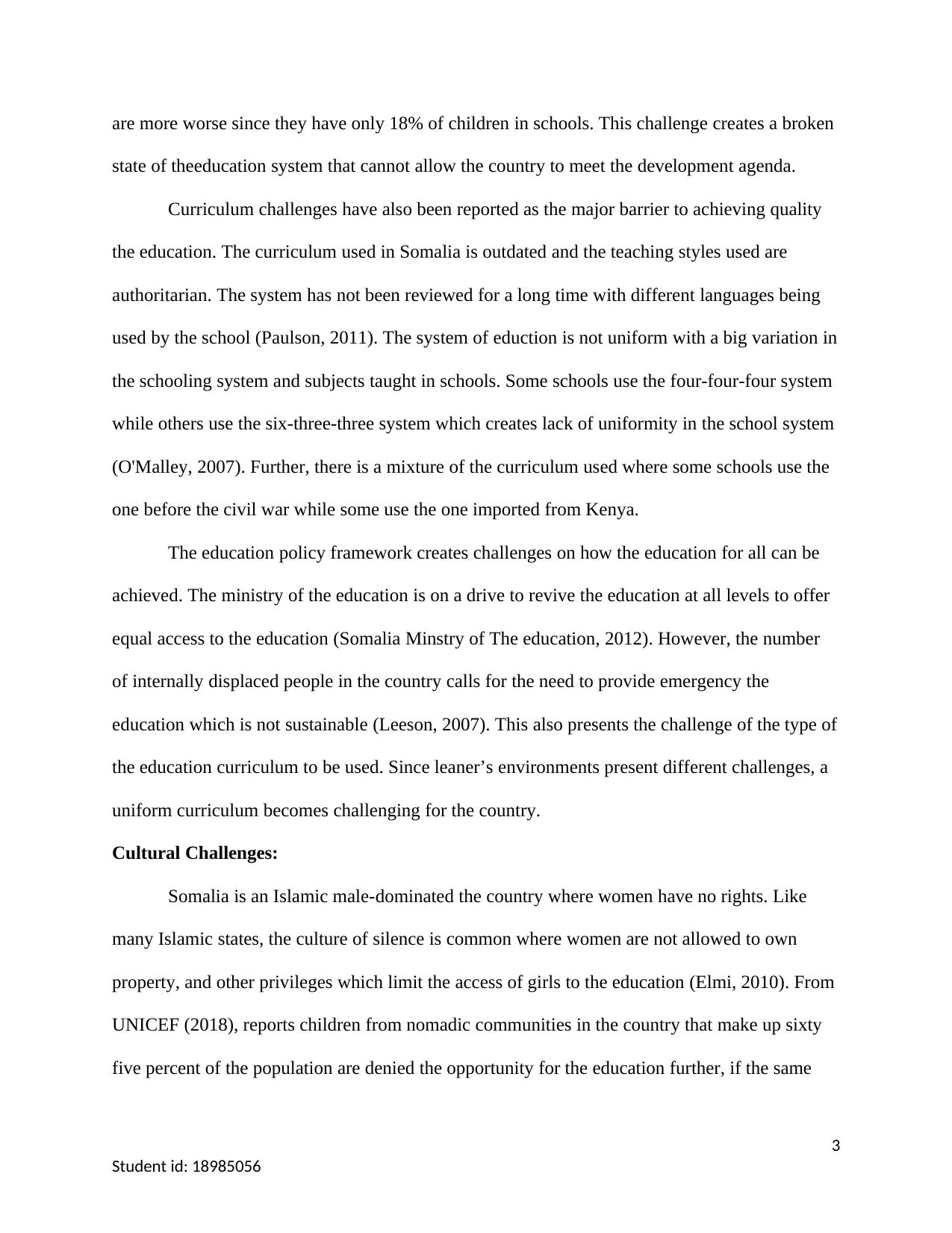
are more worse since they have only 18% of children in schools. This challenge creates a broken
state of theeducation system that cannot allow the country to meet the development agenda.
Curriculum challenges have also been reported as the major barrier to achieving quality
the education. The curriculum used in Somalia is outdated and the teaching styles used are
authoritarian. The system has not been reviewed for a long time with different languages being
used by the school (Paulson, 2011). The system of eduction is not uniform with a big variation in
the schooling system and subjects taught in schools. Some schools use the four-four-four system
while others use the six-three-three system which creates lack of uniformity in the school system
(O'Malley, 2007). Further, there is a mixture of the curriculum used where some schools use the
one before the civil war while some use the one imported from Kenya.
The education policy framework creates challenges on how the education for all can be
achieved. The ministry of the education is on a drive to revive the education at all levels to offer
equal access to the education (Somalia Minstry of The education, 2012). However, the number
of internally displaced people in the country calls for the need to provide emergency the
education which is not sustainable (Leeson, 2007). This also presents the challenge of the type of
the education curriculum to be used. Since leaner’s environments present different challenges, a
uniform curriculum becomes challenging for the country.
Cultural Challenges:
Somalia is an Islamic male-dominated the country where women have no rights. Like
many Islamic states, the culture of silence is common where women are not allowed to own
property, and other privileges which limit the access of girls to the education (Elmi, 2010). From
UNICEF (2018), reports children from nomadic communities in the country that make up sixty
five percent of the population are denied the opportunity for the education further, if the same
3
Student id: 18985056
state of theeducation system that cannot allow the country to meet the development agenda.
Curriculum challenges have also been reported as the major barrier to achieving quality
the education. The curriculum used in Somalia is outdated and the teaching styles used are
authoritarian. The system has not been reviewed for a long time with different languages being
used by the school (Paulson, 2011). The system of eduction is not uniform with a big variation in
the schooling system and subjects taught in schools. Some schools use the four-four-four system
while others use the six-three-three system which creates lack of uniformity in the school system
(O'Malley, 2007). Further, there is a mixture of the curriculum used where some schools use the
one before the civil war while some use the one imported from Kenya.
The education policy framework creates challenges on how the education for all can be
achieved. The ministry of the education is on a drive to revive the education at all levels to offer
equal access to the education (Somalia Minstry of The education, 2012). However, the number
of internally displaced people in the country calls for the need to provide emergency the
education which is not sustainable (Leeson, 2007). This also presents the challenge of the type of
the education curriculum to be used. Since leaner’s environments present different challenges, a
uniform curriculum becomes challenging for the country.
Cultural Challenges:
Somalia is an Islamic male-dominated the country where women have no rights. Like
many Islamic states, the culture of silence is common where women are not allowed to own
property, and other privileges which limit the access of girls to the education (Elmi, 2010). From
UNICEF (2018), reports children from nomadic communities in the country that make up sixty
five percent of the population are denied the opportunity for the education further, if the same
3
Student id: 18985056
⊘ This is a preview!⊘
Do you want full access?
Subscribe today to unlock all pages.

Trusted by 1+ million students worldwide
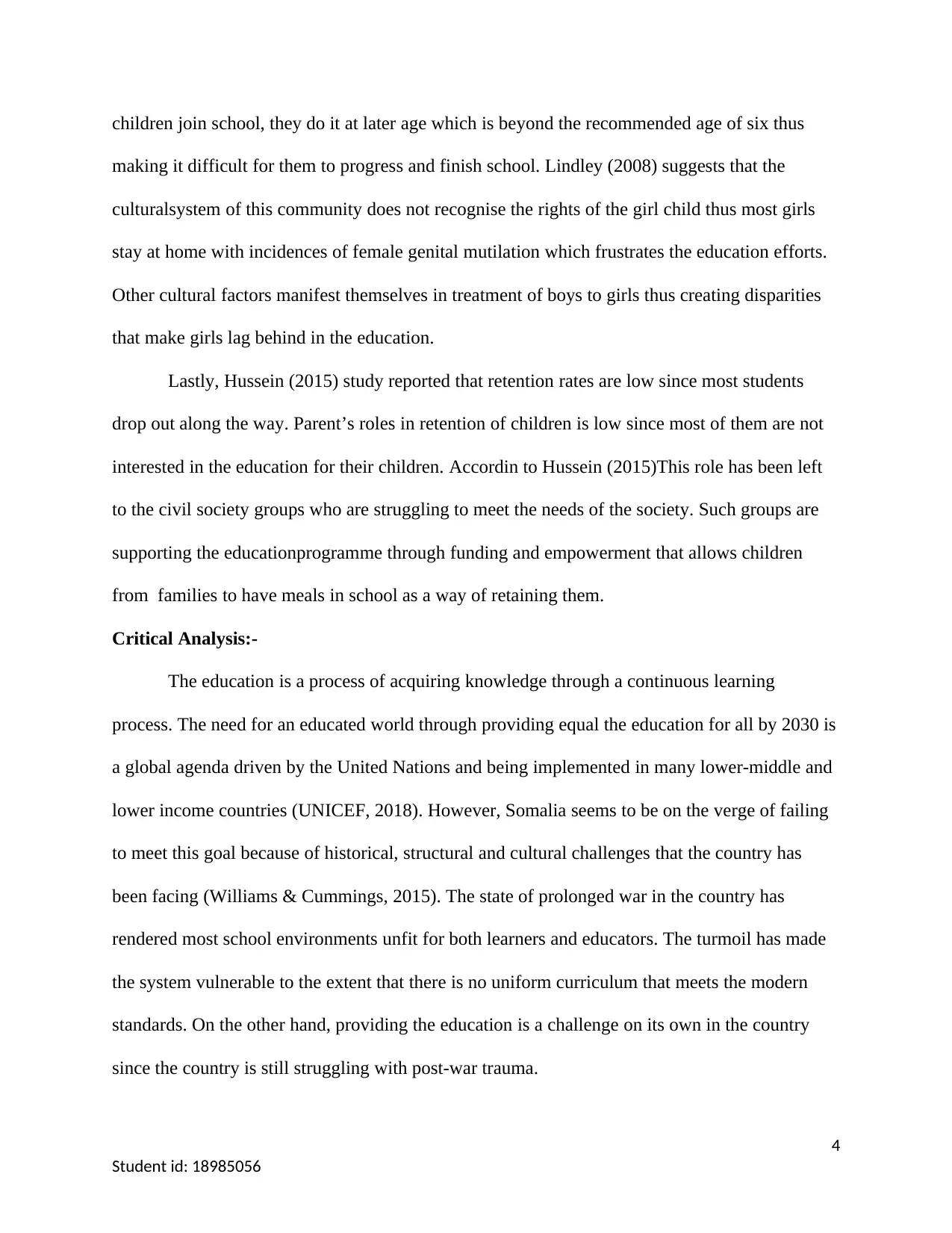
children join school, they do it at later age which is beyond the recommended age of six thus
making it difficult for them to progress and finish school. Lindley (2008) suggests that the
culturalsystem of this community does not recognise the rights of the girl child thus most girls
stay at home with incidences of female genital mutilation which frustrates the education efforts.
Other cultural factors manifest themselves in treatment of boys to girls thus creating disparities
that make girls lag behind in the education.
Lastly, Hussein (2015) study reported that retention rates are low since most students
drop out along the way. Parent’s roles in retention of children is low since most of them are not
interested in the education for their children. Accordin to Hussein (2015)This role has been left
to the civil society groups who are struggling to meet the needs of the society. Such groups are
supporting the educationprogramme through funding and empowerment that allows children
from families to have meals in school as a way of retaining them.
Critical Analysis:-
The education is a process of acquiring knowledge through a continuous learning
process. The need for an educated world through providing equal the education for all by 2030 is
a global agenda driven by the United Nations and being implemented in many lower-middle and
lower income countries (UNICEF, 2018). However, Somalia seems to be on the verge of failing
to meet this goal because of historical, structural and cultural challenges that the country has
been facing (Williams & Cummings, 2015). The state of prolonged war in the country has
rendered most school environments unfit for both learners and educators. The turmoil has made
the system vulnerable to the extent that there is no uniform curriculum that meets the modern
standards. On the other hand, providing the education is a challenge on its own in the country
since the country is still struggling with post-war trauma.
4
Student id: 18985056
making it difficult for them to progress and finish school. Lindley (2008) suggests that the
culturalsystem of this community does not recognise the rights of the girl child thus most girls
stay at home with incidences of female genital mutilation which frustrates the education efforts.
Other cultural factors manifest themselves in treatment of boys to girls thus creating disparities
that make girls lag behind in the education.
Lastly, Hussein (2015) study reported that retention rates are low since most students
drop out along the way. Parent’s roles in retention of children is low since most of them are not
interested in the education for their children. Accordin to Hussein (2015)This role has been left
to the civil society groups who are struggling to meet the needs of the society. Such groups are
supporting the educationprogramme through funding and empowerment that allows children
from families to have meals in school as a way of retaining them.
Critical Analysis:-
The education is a process of acquiring knowledge through a continuous learning
process. The need for an educated world through providing equal the education for all by 2030 is
a global agenda driven by the United Nations and being implemented in many lower-middle and
lower income countries (UNICEF, 2018). However, Somalia seems to be on the verge of failing
to meet this goal because of historical, structural and cultural challenges that the country has
been facing (Williams & Cummings, 2015). The state of prolonged war in the country has
rendered most school environments unfit for both learners and educators. The turmoil has made
the system vulnerable to the extent that there is no uniform curriculum that meets the modern
standards. On the other hand, providing the education is a challenge on its own in the country
since the country is still struggling with post-war trauma.
4
Student id: 18985056
Paraphrase This Document
Need a fresh take? Get an instant paraphrase of this document with our AI Paraphraser
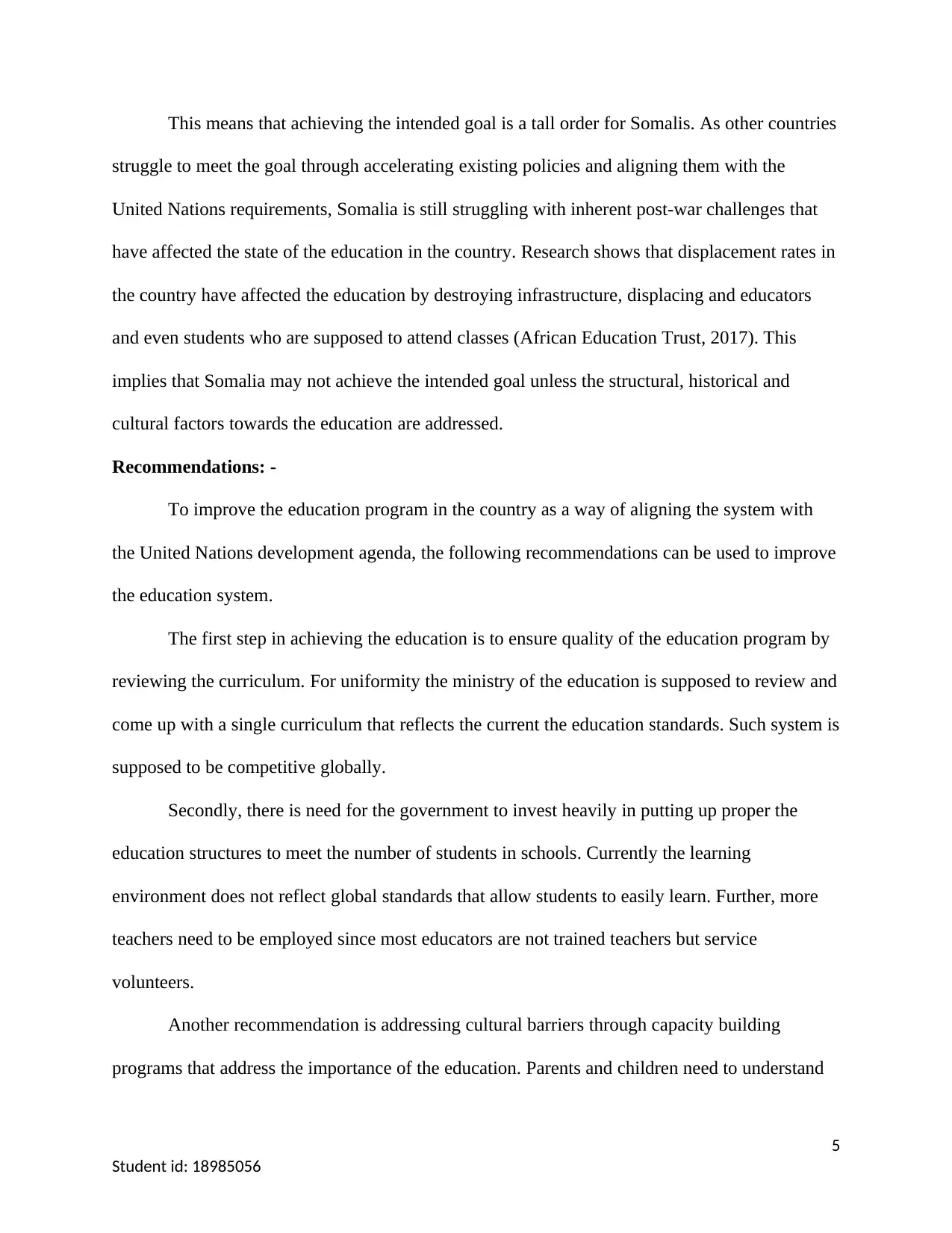
This means that achieving the intended goal is a tall order for Somalis. As other countries
struggle to meet the goal through accelerating existing policies and aligning them with the
United Nations requirements, Somalia is still struggling with inherent post-war challenges that
have affected the state of the education in the country. Research shows that displacement rates in
the country have affected the education by destroying infrastructure, displacing and educators
and even students who are supposed to attend classes (African Education Trust, 2017). This
implies that Somalia may not achieve the intended goal unless the structural, historical and
cultural factors towards the education are addressed.
Recommendations: -
To improve the education program in the country as a way of aligning the system with
the United Nations development agenda, the following recommendations can be used to improve
the education system.
The first step in achieving the education is to ensure quality of the education program by
reviewing the curriculum. For uniformity the ministry of the education is supposed to review and
come up with a single curriculum that reflects the current the education standards. Such system is
supposed to be competitive globally.
Secondly, there is need for the government to invest heavily in putting up proper the
education structures to meet the number of students in schools. Currently the learning
environment does not reflect global standards that allow students to easily learn. Further, more
teachers need to be employed since most educators are not trained teachers but service
volunteers.
Another recommendation is addressing cultural barriers through capacity building
programs that address the importance of the education. Parents and children need to understand
5
Student id: 18985056
struggle to meet the goal through accelerating existing policies and aligning them with the
United Nations requirements, Somalia is still struggling with inherent post-war challenges that
have affected the state of the education in the country. Research shows that displacement rates in
the country have affected the education by destroying infrastructure, displacing and educators
and even students who are supposed to attend classes (African Education Trust, 2017). This
implies that Somalia may not achieve the intended goal unless the structural, historical and
cultural factors towards the education are addressed.
Recommendations: -
To improve the education program in the country as a way of aligning the system with
the United Nations development agenda, the following recommendations can be used to improve
the education system.
The first step in achieving the education is to ensure quality of the education program by
reviewing the curriculum. For uniformity the ministry of the education is supposed to review and
come up with a single curriculum that reflects the current the education standards. Such system is
supposed to be competitive globally.
Secondly, there is need for the government to invest heavily in putting up proper the
education structures to meet the number of students in schools. Currently the learning
environment does not reflect global standards that allow students to easily learn. Further, more
teachers need to be employed since most educators are not trained teachers but service
volunteers.
Another recommendation is addressing cultural barriers through capacity building
programs that address the importance of the education. Parents and children need to understand
5
Student id: 18985056
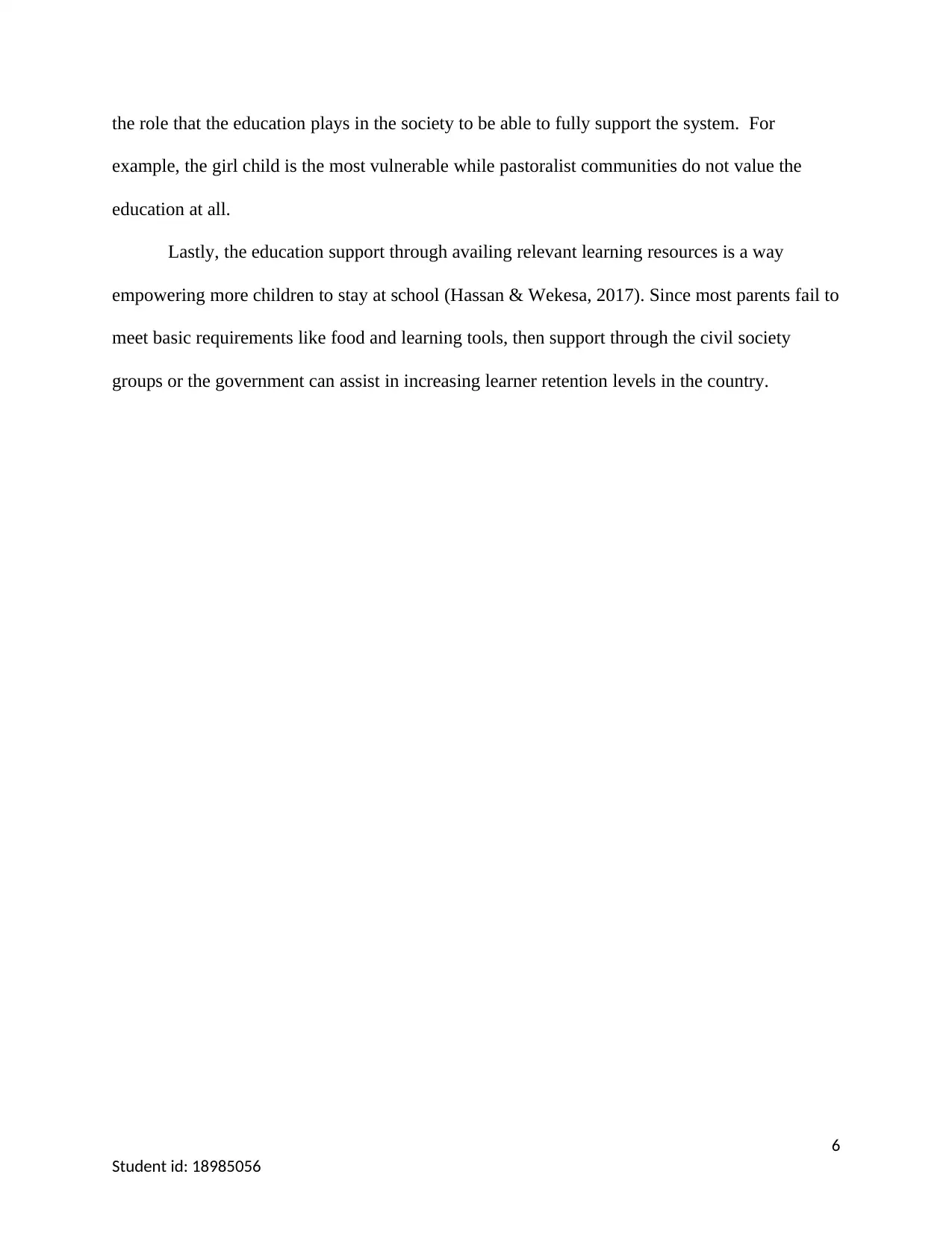
the role that the education plays in the society to be able to fully support the system. For
example, the girl child is the most vulnerable while pastoralist communities do not value the
education at all.
Lastly, the education support through availing relevant learning resources is a way
empowering more children to stay at school (Hassan & Wekesa, 2017). Since most parents fail to
meet basic requirements like food and learning tools, then support through the civil society
groups or the government can assist in increasing learner retention levels in the country.
6
Student id: 18985056
example, the girl child is the most vulnerable while pastoralist communities do not value the
education at all.
Lastly, the education support through availing relevant learning resources is a way
empowering more children to stay at school (Hassan & Wekesa, 2017). Since most parents fail to
meet basic requirements like food and learning tools, then support through the civil society
groups or the government can assist in increasing learner retention levels in the country.
6
Student id: 18985056
⊘ This is a preview!⊘
Do you want full access?
Subscribe today to unlock all pages.

Trusted by 1+ million students worldwide
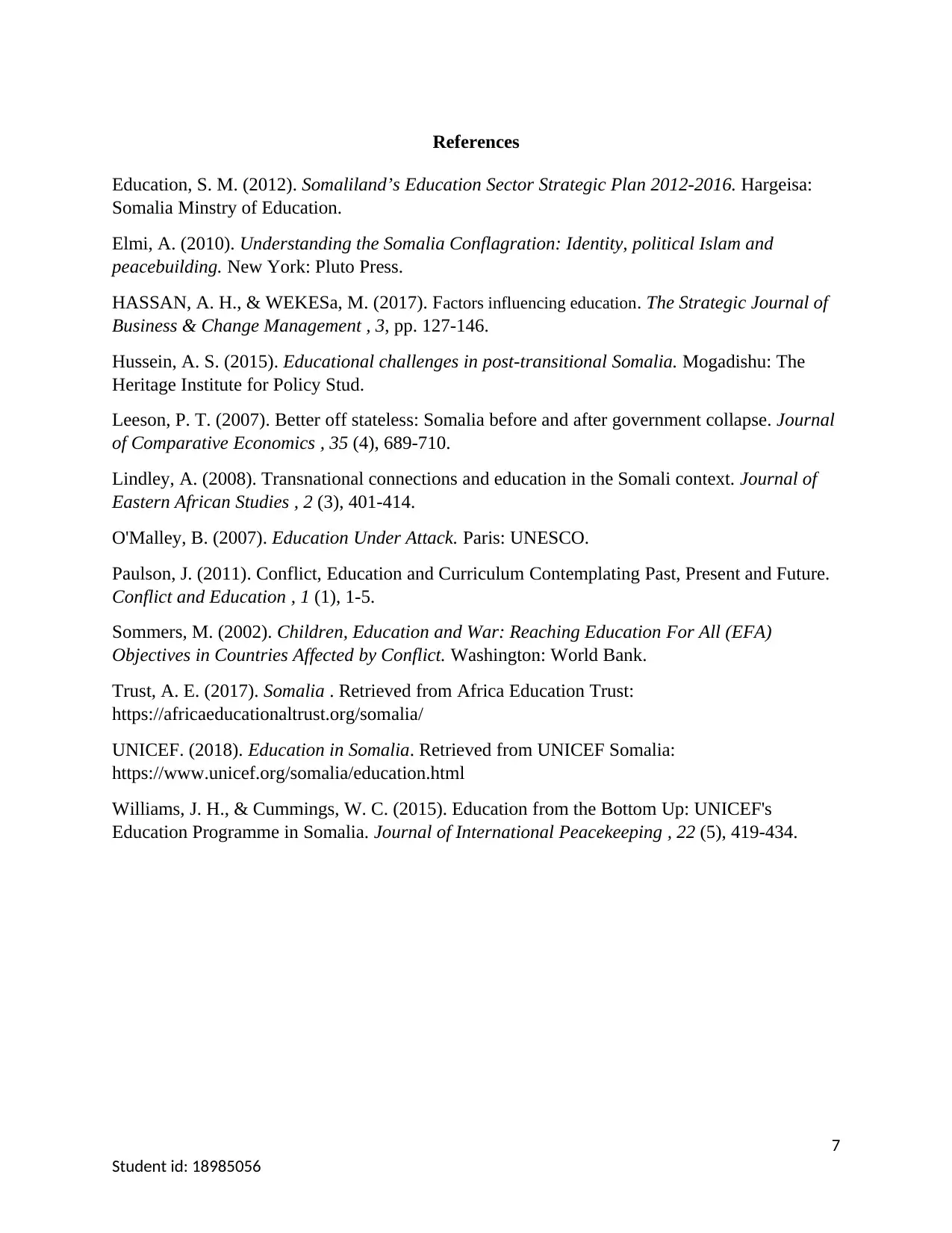
References
Education, S. M. (2012). Somaliland’s Education Sector Strategic Plan 2012-2016. Hargeisa:
Somalia Minstry of Education.
Elmi, A. (2010). Understanding the Somalia Conflagration: Identity, political Islam and
peacebuilding. New York: Pluto Press.
HASSAN, A. H., & WEKESa, M. (2017). Factors influencing education. The Strategic Journal of
Business & Change Management , 3, pp. 127-146.
Hussein, A. S. (2015). Educational challenges in post-transitional Somalia. Mogadishu: The
Heritage Institute for Policy Stud.
Leeson, P. T. (2007). Better off stateless: Somalia before and after government collapse. Journal
of Comparative Economics , 35 (4), 689-710.
Lindley, A. (2008). Transnational connections and education in the Somali context. Journal of
Eastern African Studies , 2 (3), 401-414.
O'Malley, B. (2007). Education Under Attack. Paris: UNESCO.
Paulson, J. (2011). Conflict, Education and Curriculum Contemplating Past, Present and Future.
Conflict and Education , 1 (1), 1-5.
Sommers, M. (2002). Children, Education and War: Reaching Education For All (EFA)
Objectives in Countries Affected by Conflict. Washington: World Bank.
Trust, A. E. (2017). Somalia . Retrieved from Africa Education Trust:
https://africaeducationaltrust.org/somalia/
UNICEF. (2018). Education in Somalia. Retrieved from UNICEF Somalia:
https://www.unicef.org/somalia/education.html
Williams, J. H., & Cummings, W. C. (2015). Education from the Bottom Up: UNICEF's
Education Programme in Somalia. Journal of International Peacekeeping , 22 (5), 419-434.
7
Student id: 18985056
Education, S. M. (2012). Somaliland’s Education Sector Strategic Plan 2012-2016. Hargeisa:
Somalia Minstry of Education.
Elmi, A. (2010). Understanding the Somalia Conflagration: Identity, political Islam and
peacebuilding. New York: Pluto Press.
HASSAN, A. H., & WEKESa, M. (2017). Factors influencing education. The Strategic Journal of
Business & Change Management , 3, pp. 127-146.
Hussein, A. S. (2015). Educational challenges in post-transitional Somalia. Mogadishu: The
Heritage Institute for Policy Stud.
Leeson, P. T. (2007). Better off stateless: Somalia before and after government collapse. Journal
of Comparative Economics , 35 (4), 689-710.
Lindley, A. (2008). Transnational connections and education in the Somali context. Journal of
Eastern African Studies , 2 (3), 401-414.
O'Malley, B. (2007). Education Under Attack. Paris: UNESCO.
Paulson, J. (2011). Conflict, Education and Curriculum Contemplating Past, Present and Future.
Conflict and Education , 1 (1), 1-5.
Sommers, M. (2002). Children, Education and War: Reaching Education For All (EFA)
Objectives in Countries Affected by Conflict. Washington: World Bank.
Trust, A. E. (2017). Somalia . Retrieved from Africa Education Trust:
https://africaeducationaltrust.org/somalia/
UNICEF. (2018). Education in Somalia. Retrieved from UNICEF Somalia:
https://www.unicef.org/somalia/education.html
Williams, J. H., & Cummings, W. C. (2015). Education from the Bottom Up: UNICEF's
Education Programme in Somalia. Journal of International Peacekeeping , 22 (5), 419-434.
7
Student id: 18985056
1 out of 7
Related Documents
Your All-in-One AI-Powered Toolkit for Academic Success.
+13062052269
info@desklib.com
Available 24*7 on WhatsApp / Email
![[object Object]](/_next/static/media/star-bottom.7253800d.svg)
Unlock your academic potential
Copyright © 2020–2025 A2Z Services. All Rights Reserved. Developed and managed by ZUCOL.





